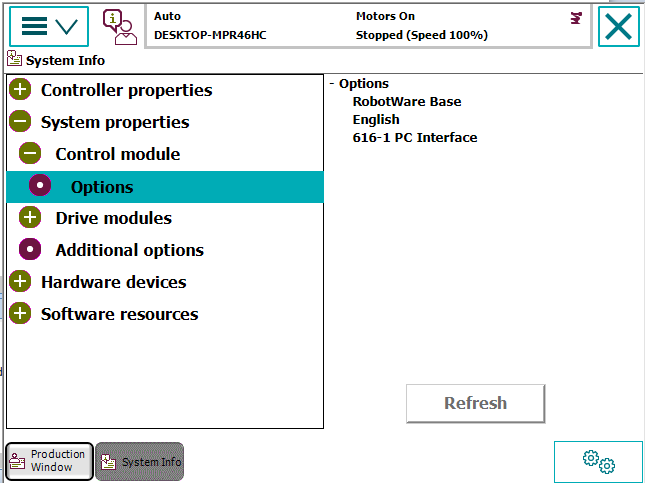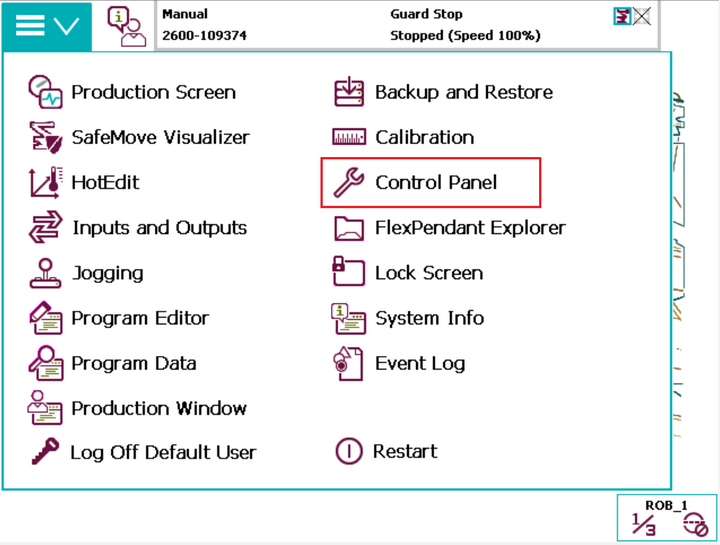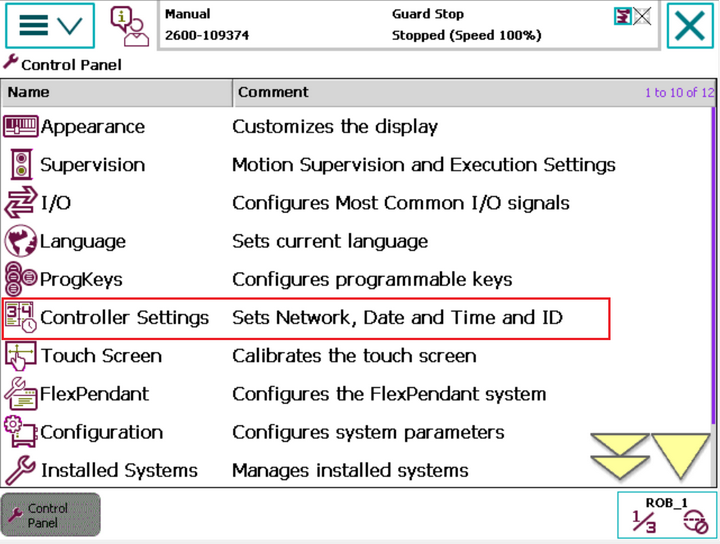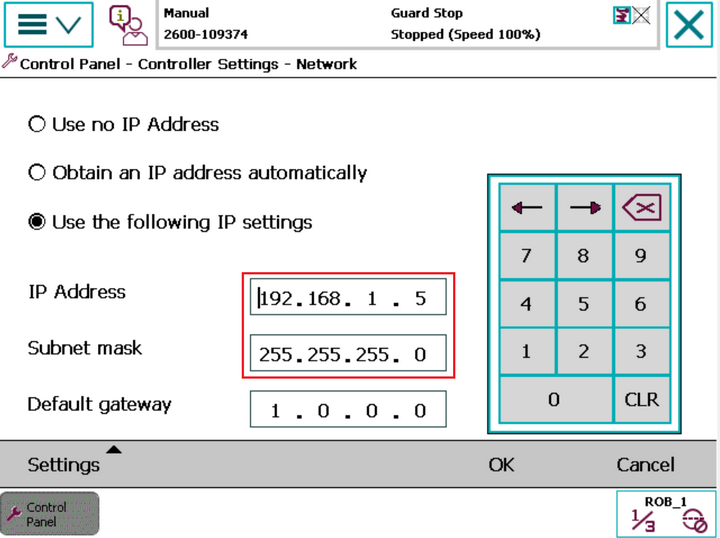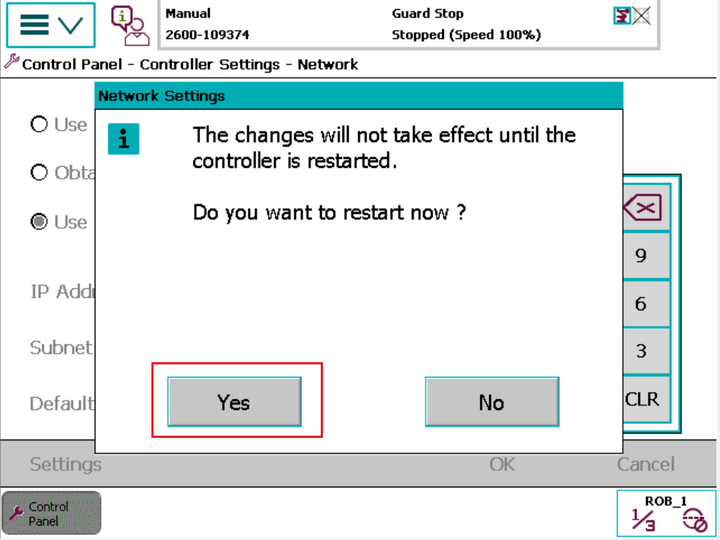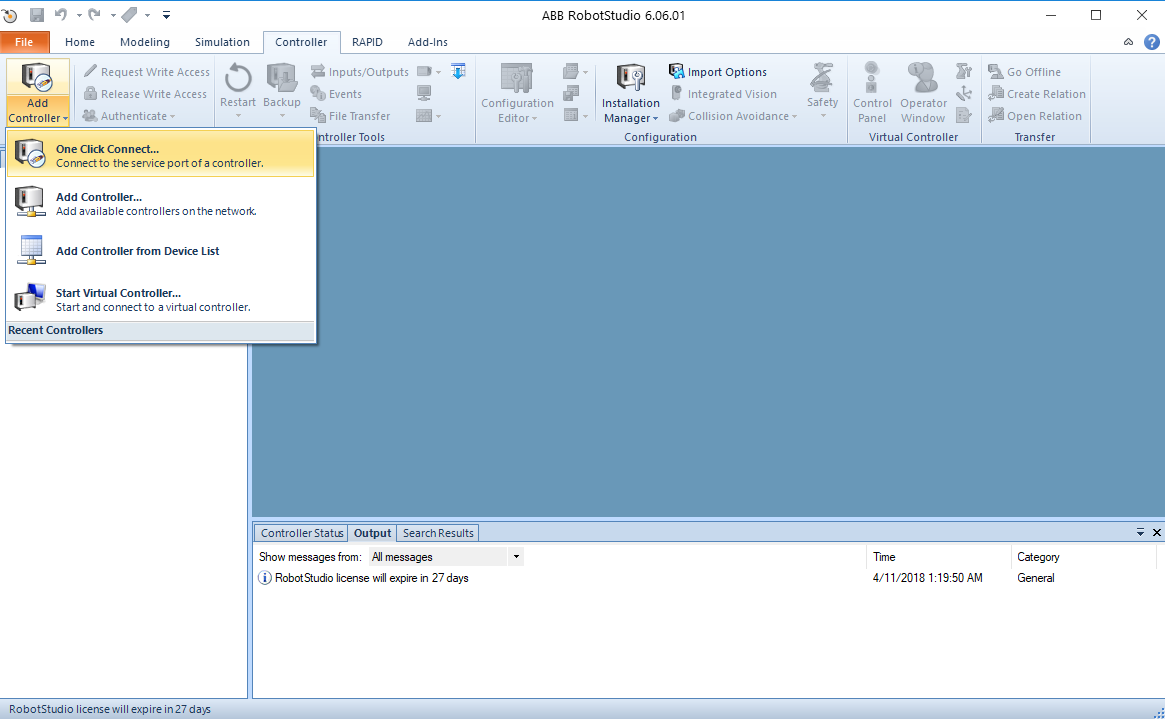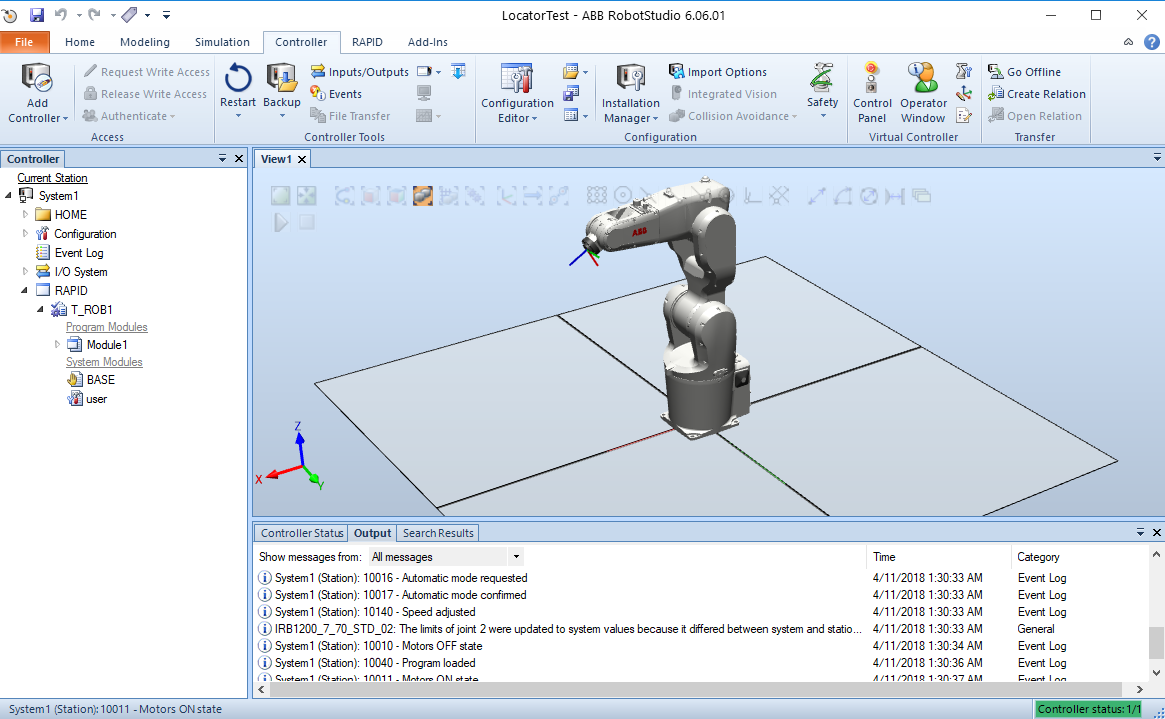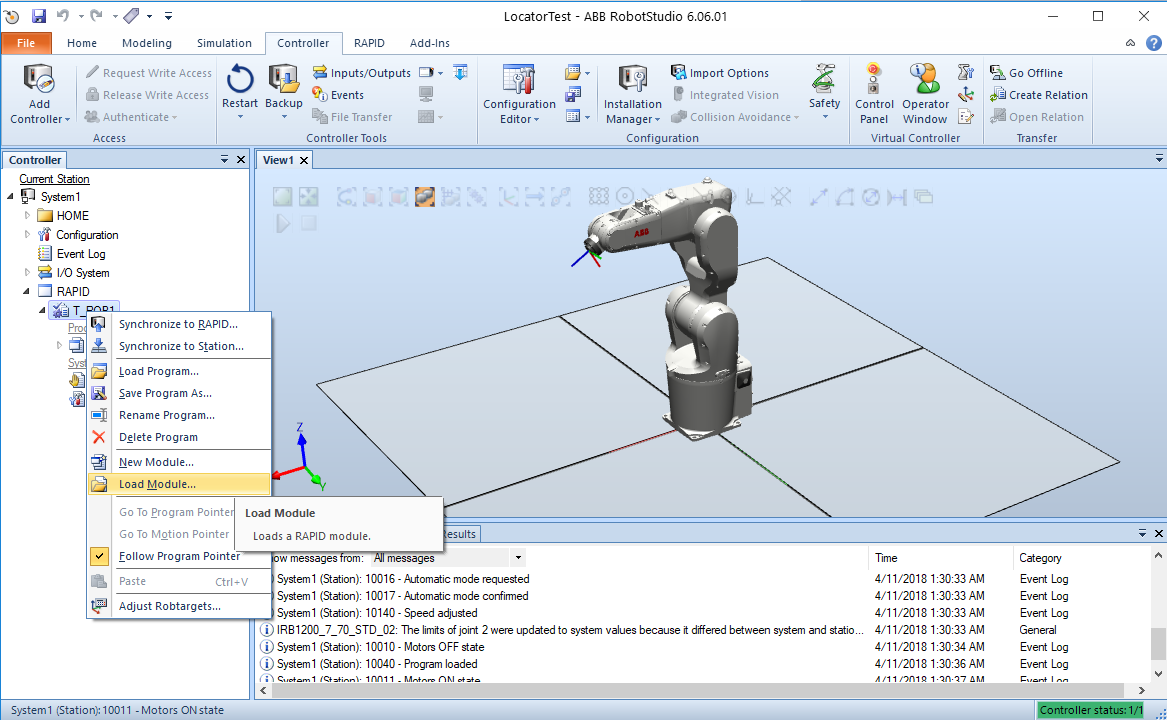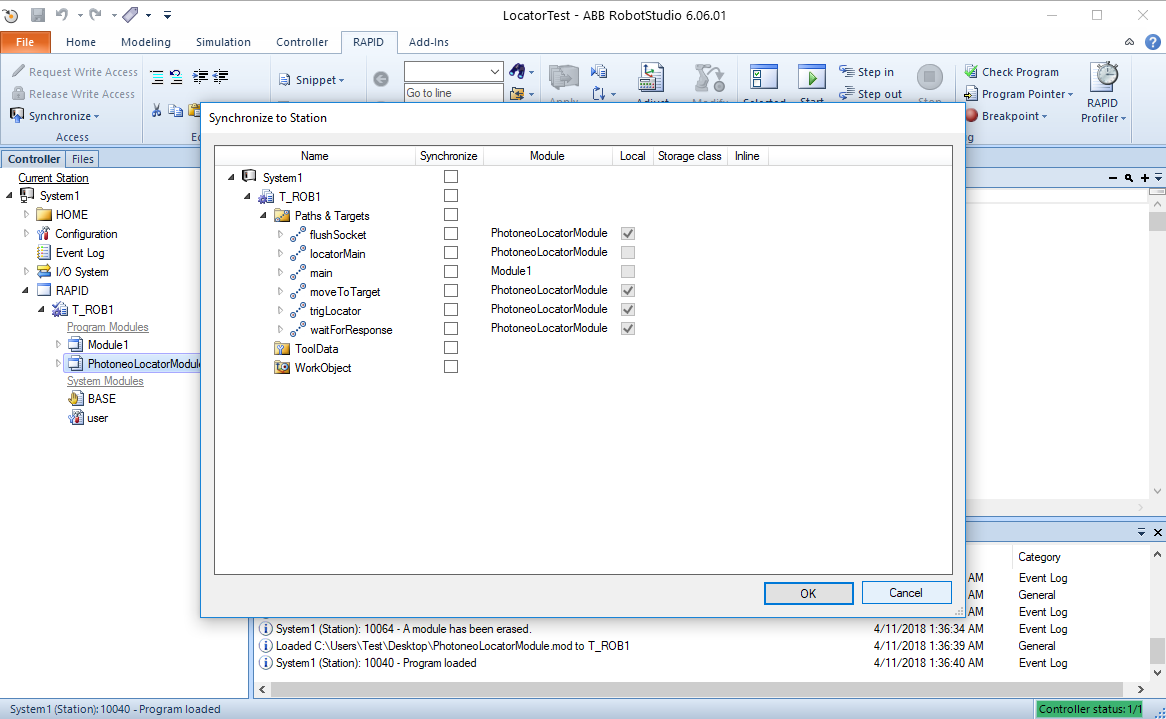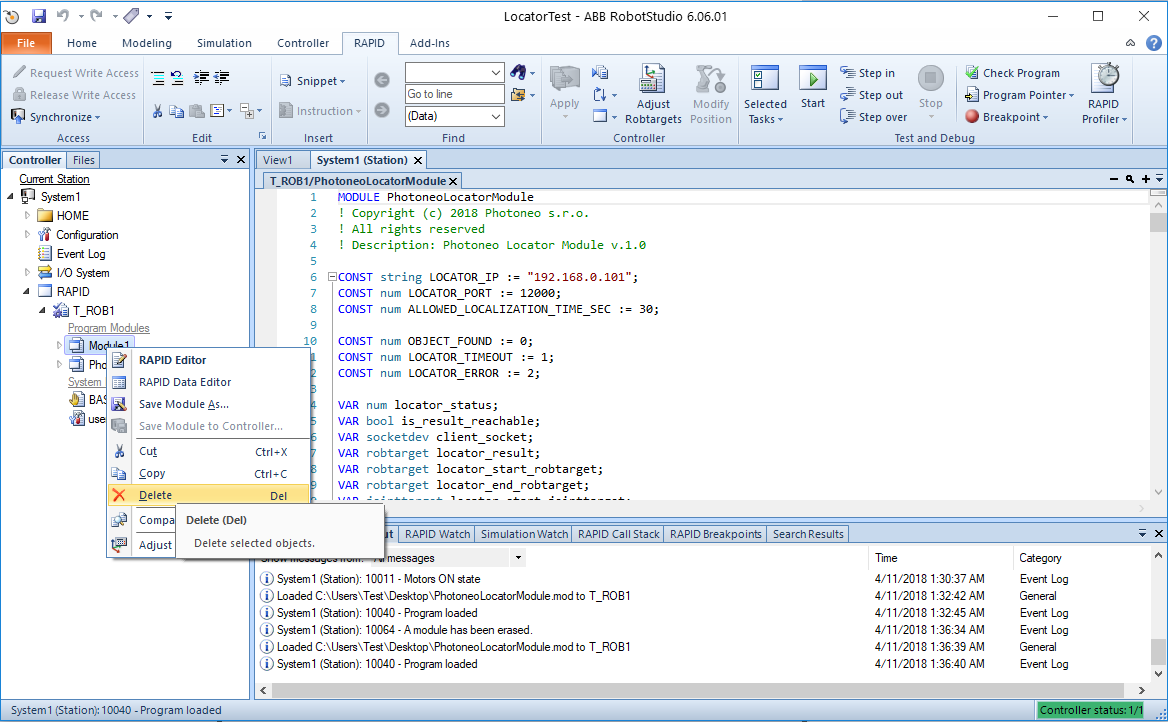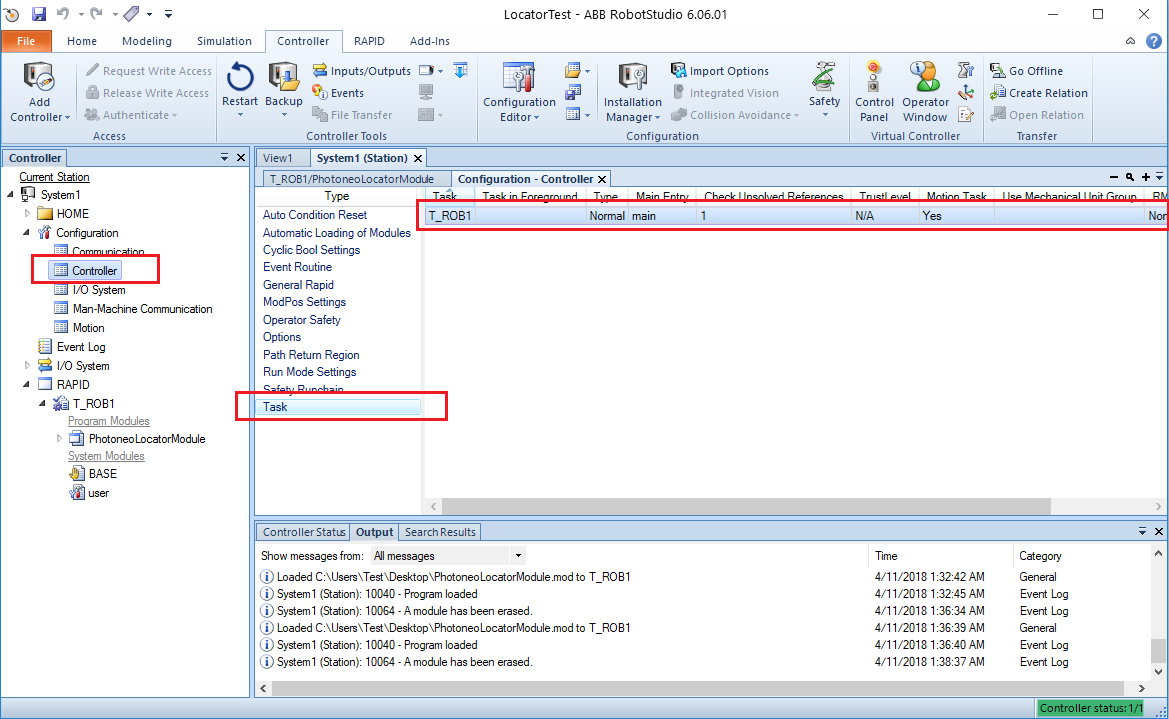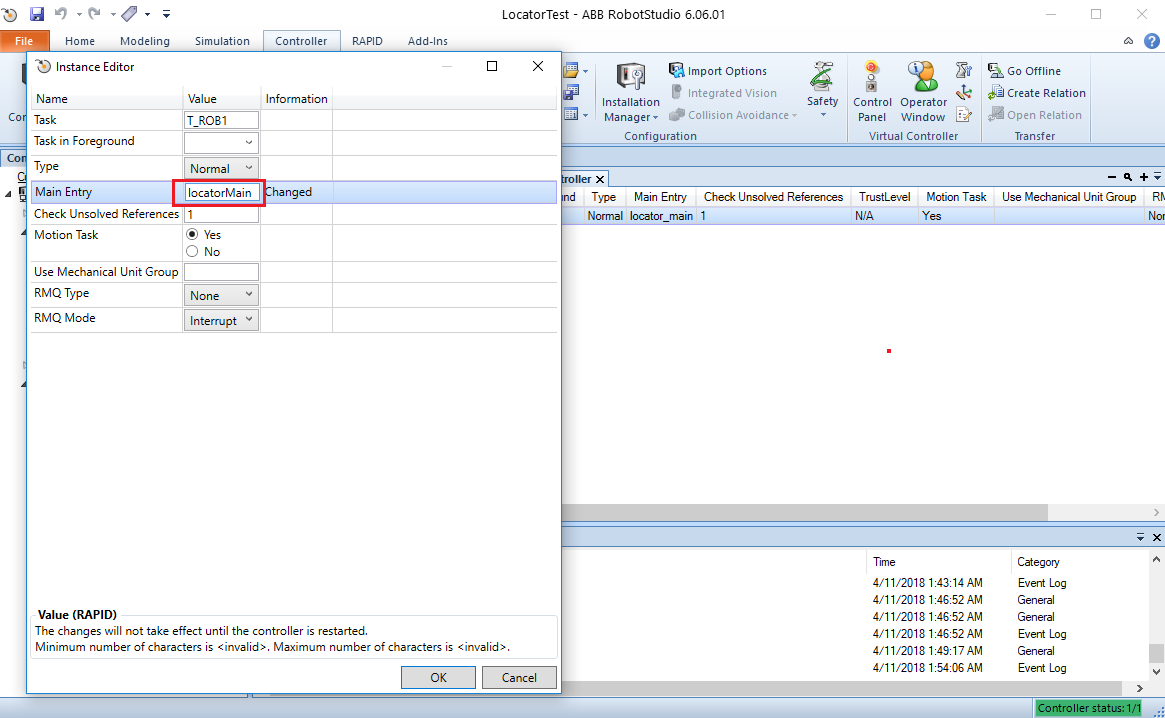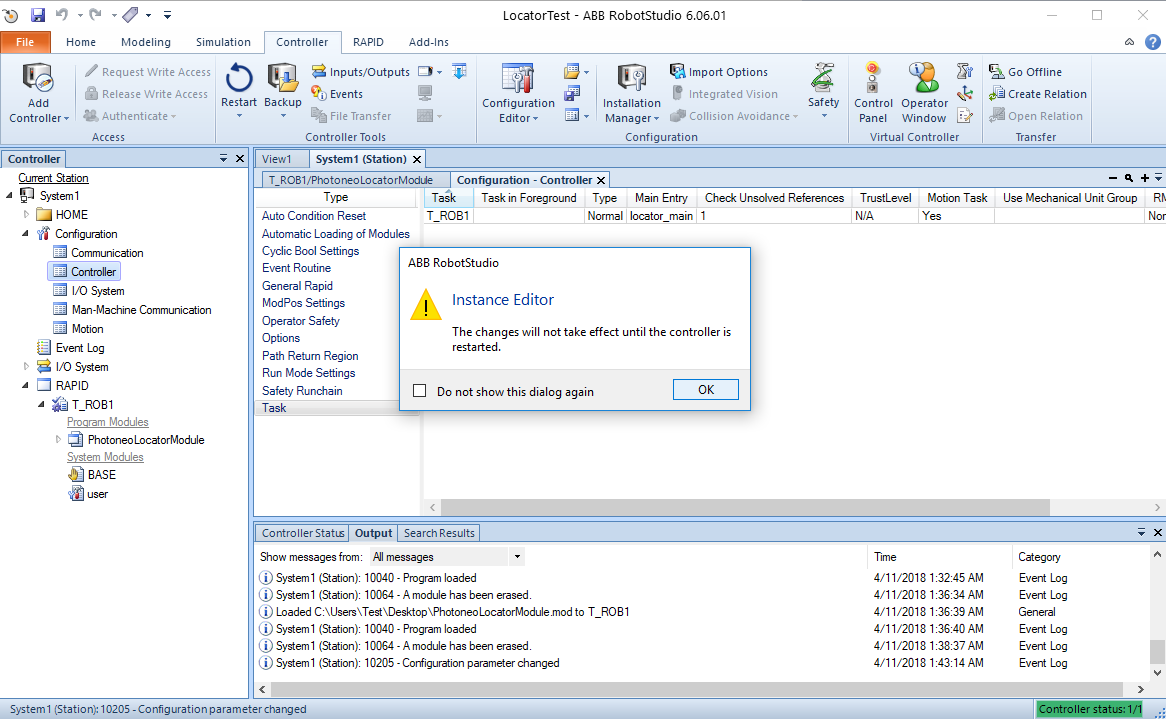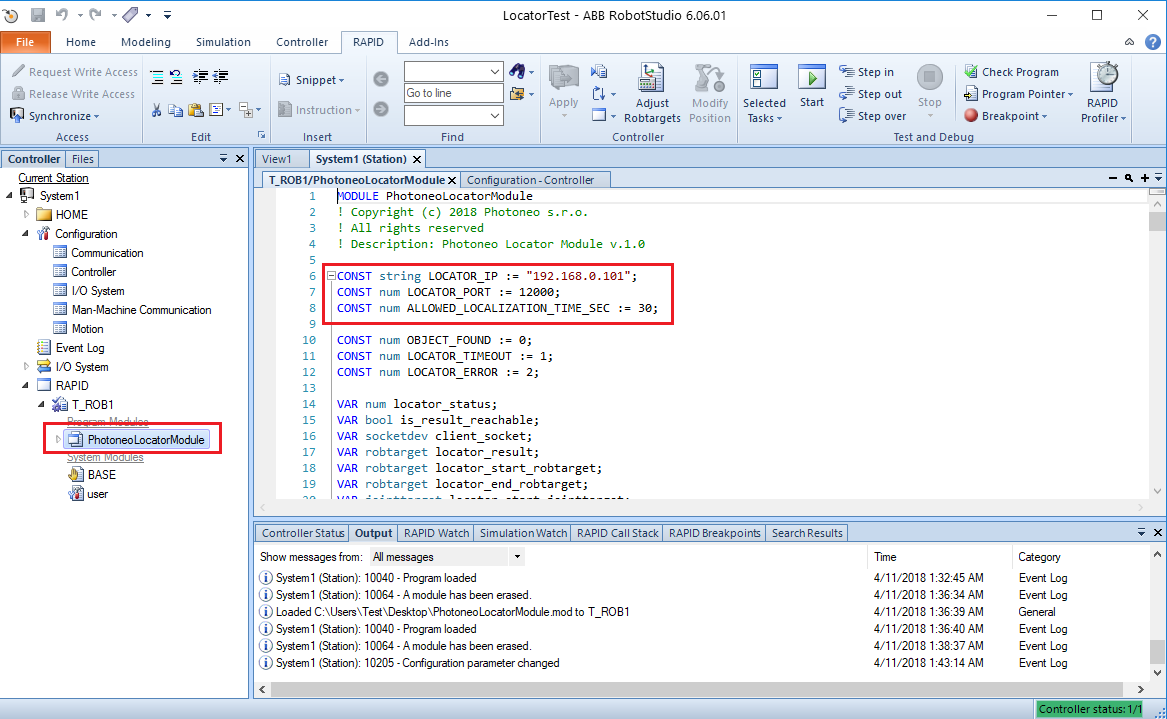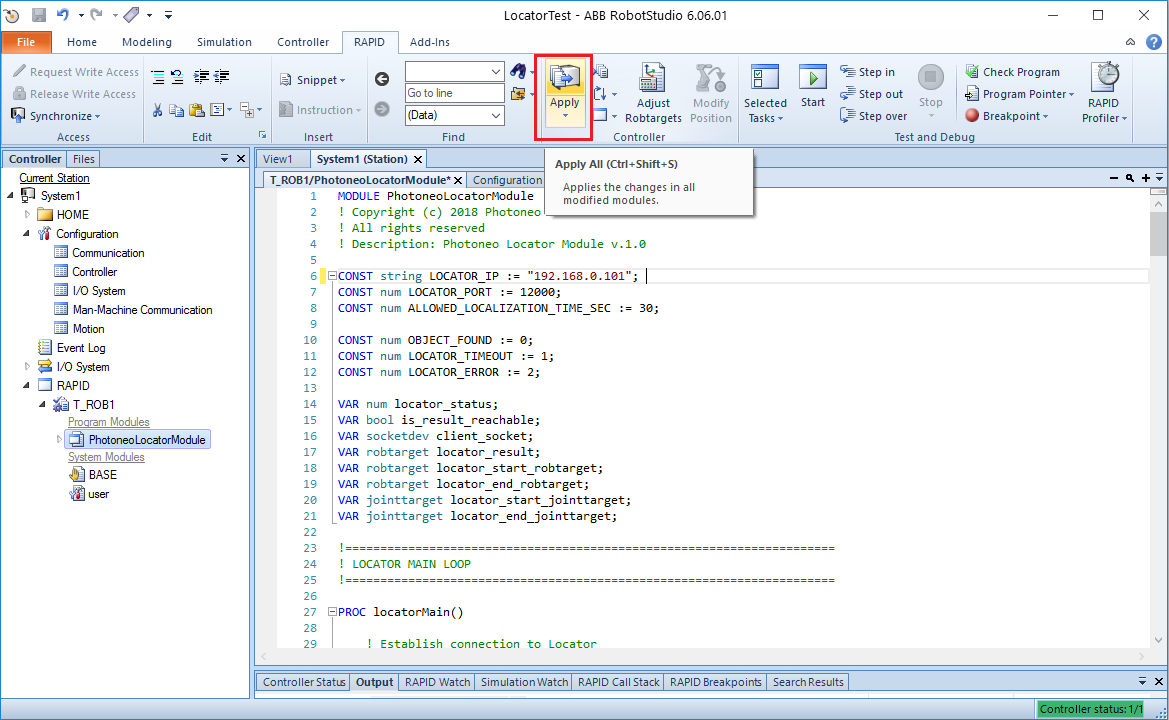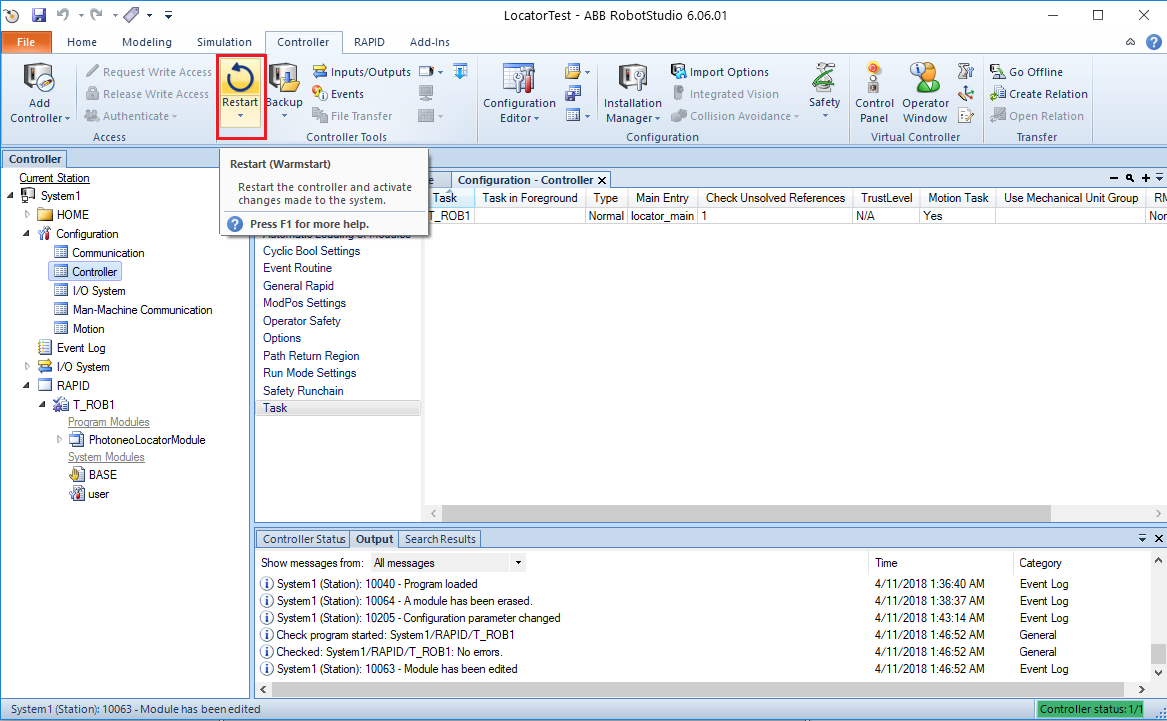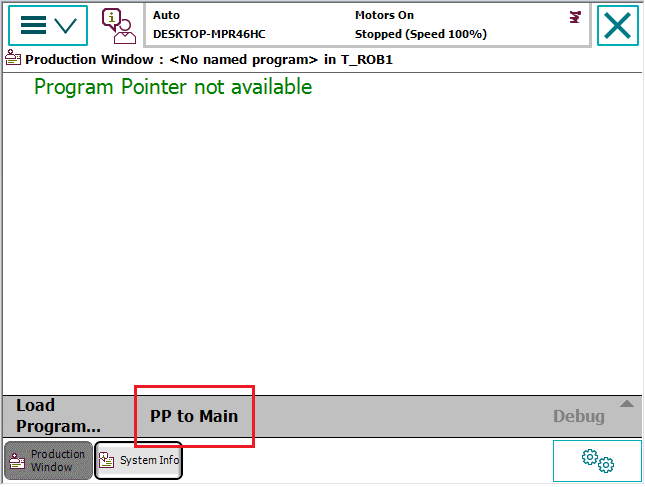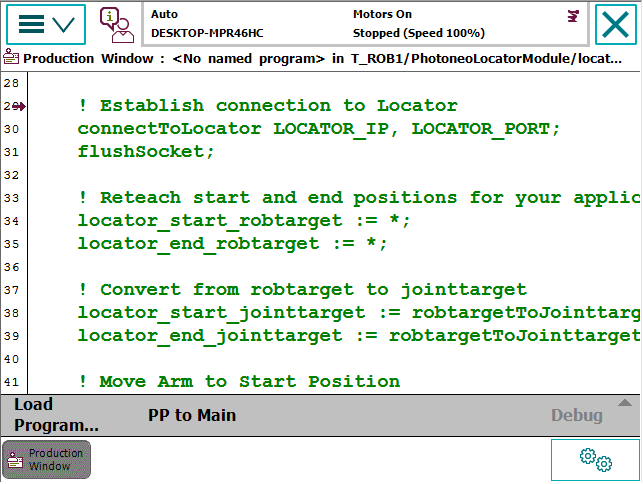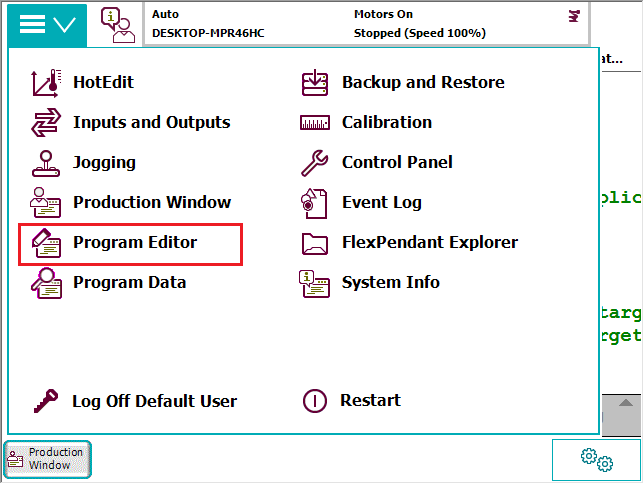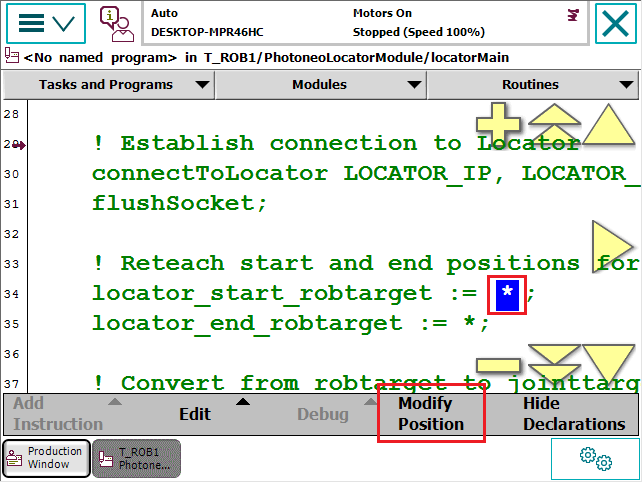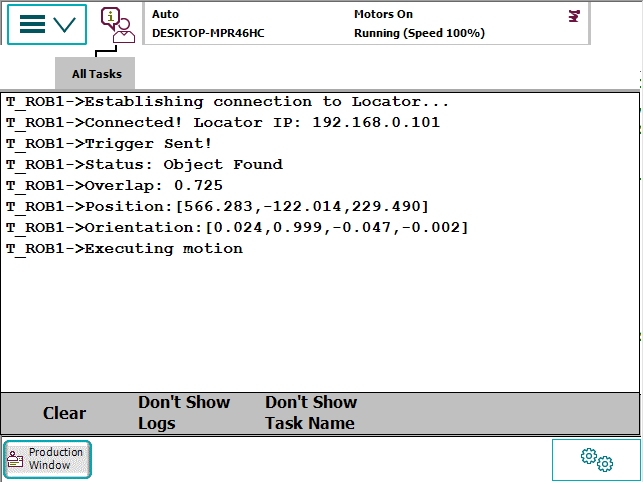Difference between revisions of "Locator Tutorial: Setting up Locator to work with ABB robots"
| Line 3: | Line 3: | ||
Locator ABB Interface is compatible with '''RobotWareOS versions 5.13 and higher'''. | Locator ABB Interface is compatible with '''RobotWareOS versions 5.13 and higher'''. | ||
| − | + | System options required for Locator ABB Interface: | |
| − | Using Pendant go to '''System Info -> System Properties -> Control Module -> Options''' to check | + | '''-(616-6) PC Interface Module''' |
| + | |||
| + | Using Pendant go to '''System Info -> System Properties -> Control Module -> Options''' to check required options are available within your system: | ||
| Line 15: | Line 17: | ||
== 2. ABB Controller setup == | == 2. ABB Controller setup == | ||
| − | The following tutorial gives a step by step guide of how to configure your ABB IRC5 controller and install | + | The following tutorial gives a step by step guide of how to configure your ABB IRC5 controller and install RAPID files to get the interface up and running. |
This tutorial was originally written using the latest '''RobotWare v.6.06''', however it should be compatible with older versions with minor changes. | This tutorial was originally written using the latest '''RobotWare v.6.06''', however it should be compatible with older versions with minor changes. | ||
| Line 65: | Line 67: | ||
| − | If everything is | + | If everything is configured correctly, Robot Studio should connect to the IRC5 controller and you should see the content of '''"Current Station"''' in the left pane. |
| − | NOTE: | + | NOTE: As you can see for the purpose of writing this tutorial an ABB IRB1200 7kg was used. |
| Line 73: | Line 75: | ||
| − | + | Now we need to upload '''PhotoneoLocatorModule''' to the controller. Right Click on '''T_ROB1''' task and select '''Load Module''' option. Browse to the '''PhotoneoLocatorModule.mod''' and hit '''Open'''. | |
| − | You should see PhotoneoLocatorModule | + | You should see that '''PhotoneoLocatorModule''' has appeared in the T_ROB1 module list. |
| Line 87: | Line 89: | ||
| − | In case you are working with clean system and you do not plan to make use of default '''Module1''' feel free to delete it. | + | In case you are working with a clean system and you do not plan to make use of default '''Module1''' feel free to delete it. |
| Line 93: | Line 95: | ||
| − | Now we need to set PhotoneoLocatorModule to become the main | + | Now we need to set '''PhotoneoLocatorModule''' to become the main program. On the left pane, select '''Controller''' -> '''Configuration''' -> '''Task''' |
| Line 107: | Line 109: | ||
| − | Since this is a major change to the system, a restart is needed in order to take | + | Since this is a major change to the system, a restart is needed in order to take effect. Hit '''OK''' here, we will restart system later on. |
| Line 113: | Line 115: | ||
| − | Now open '''PhotoneLocatorModule''' in the left pane to see the '''RAPID code'''. Adopt first three constants to meet your application requirements and network | + | Now open '''PhotoneLocatorModule''' in the left pane to see the '''RAPID code'''. Adopt first three constants to meet your application requirements and network configuration. |
| Line 119: | Line 121: | ||
| − | Click Apply button when finished | + | Click '''Apply''' button when finished |
| Line 125: | Line 127: | ||
| − | Now it is the time to '''Restart''' the system. Use Restart button in | + | Now it is the time to '''Restart''' the system. Use Restart button in Robot Studio or directly on the Pendant. |
| Line 131: | Line 133: | ||
| − | After | + | After system reboot open the '''Production Window''' and hit '''PP to Main''' button. |
| Line 137: | Line 139: | ||
| − | You should see the PhotoneoLocatorModule being properly loaded with the Program Pointer set as shown in the figure below: | + | You should see the PhotoneoLocatorModule being properly loaded with the '''Program Pointer''' set as shown in the figure below: |
| Line 143: | Line 145: | ||
| − | Before we can play the program we need to ''' | + | Before we can play the program we need to '''Reteach Start and End positions''' to meet your application requirements. From the Main menu select the '''Program Editor''' tool. |
| Line 149: | Line 151: | ||
| − | Switch to the Manual mode, jog the robot to your desired start position, select the asterisk at the '''locator_start_robtarget''' line and hit '''Modify Position'''. | + | Switch to the '''Manual mode''', jog the robot to your desired start position, select the asterisk at the '''locator_start_robtarget''' line and hit '''Modify Position'''. |
| − | Repeat the same procedure for locator end position | + | Repeat the same procedure for locator end position. |
| Line 157: | Line 159: | ||
| − | Now you are ready to run the program. Switch back to Auto mode, due to safety reasons select 10% speed | + | Now you are ready to run the program. Switch back to '''Auto mode''', Plug Ethernet cable to pre-configured '''WAN port''' and due to safety reasons '''select 10% speed'''. Open '''Production Window''', '''PP to Main''' and hit '''Play'''. |
Make sure that you are ready to stop the motion execution immediately in case if something goes wrong. | Make sure that you are ready to stop the motion execution immediately in case if something goes wrong. | ||
| − | If everything | + | If everything was configured and calibrated properly robot should trigger a first scan wait for result and move to towards first localized object if the returned pose is reachable. |
| + | |||
| + | You can monitor program steps on info og panel directly on the pendant. | ||
[[File: Locator ABB tutorial step18.PNG]] | [[File: Locator ABB tutorial step18.PNG]] | ||
| + | |||
| + | |||
| + | If you are satisfied with the basic locator functionality feel free to adopt RAPID code, change speed, precision or the order to steps in the main loop. | ||
Revision as of 13:44, 11 April 2018
Contents
1. Prerequisities
Locator ABB Interface is compatible with RobotWareOS versions 5.13 and higher.
System options required for Locator ABB Interface:
-(616-6) PC Interface Module
Using Pendant go to System Info -> System Properties -> Control Module -> Options to check required options are available within your system:
NOTE: Use of Robot Studio v.6.06 or higher is highly recommended for Locator ABB Interface setup.
2. ABB Controller setup
The following tutorial gives a step by step guide of how to configure your ABB IRC5 controller and install RAPID files to get the interface up and running.
This tutorial was originally written using the latest RobotWare v.6.06, however it should be compatible with older versions with minor changes.
2.1 Network configuration
NOTE: The network configuration procedure described below only works with RobotWareOS v.6 or higher. If you have an older version of RobotWareOS and need to change an IP address, please contact local ABB support.
Turn on the IRC5 Controller, wait for the Initialization Screen to appear, open the Menu screen and select the Control Panel option:
In the Control Panel pane, select Controller Settings:
Select Settings and choose the Network option:
The Network Settings window should now appear. Use the Touch Panel Keypad to set the IP address of the IRC5 WAN port:
Choose OK button and restart the Controller to apply the new settings:
3 Robot Studio Setup
3.1 Connect to IRC5 Controller from Robot Studio
Set your local PC network settings to DHCP, plug an Ethernet cable into the Service Port of the IRC5 Controller and launch Robot Studio.
For a direct connection to the Robot Controller, select the Controller tab and select the One Click Connect option:
If everything is configured correctly, Robot Studio should connect to the IRC5 controller and you should see the content of "Current Station" in the left pane.
NOTE: As you can see for the purpose of writing this tutorial an ABB IRB1200 7kg was used.
Now we need to upload PhotoneoLocatorModule to the controller. Right Click on T_ROB1 task and select Load Module option. Browse to the PhotoneoLocatorModule.mod and hit Open.
You should see that PhotoneoLocatorModule has appeared in the T_ROB1 module list.
If Synchronize to Station dialog panel appears, just click Cancel, we will synchronize later.
In case you are working with a clean system and you do not plan to make use of default Module1 feel free to delete it.
Now we need to set PhotoneoLocatorModule to become the main program. On the left pane, select Controller -> Configuration -> Task
Now double click on T_ROB1 task. Instance Editor dialog screen should appear.
Here change Main Entry to Locator main fucntion which is called locatorMain and Hit OK.
Since this is a major change to the system, a restart is needed in order to take effect. Hit OK here, we will restart system later on.
Now open PhotoneLocatorModule in the left pane to see the RAPID code. Adopt first three constants to meet your application requirements and network configuration.
Click Apply button when finished
Now it is the time to Restart the system. Use Restart button in Robot Studio or directly on the Pendant.
After system reboot open the Production Window and hit PP to Main button.
You should see the PhotoneoLocatorModule being properly loaded with the Program Pointer set as shown in the figure below:
Before we can play the program we need to Reteach Start and End positions to meet your application requirements. From the Main menu select the Program Editor tool.
Switch to the Manual mode, jog the robot to your desired start position, select the asterisk at the locator_start_robtarget line and hit Modify Position.
Repeat the same procedure for locator end position.
Now you are ready to run the program. Switch back to Auto mode, Plug Ethernet cable to pre-configured WAN port and due to safety reasons select 10% speed. Open Production Window, PP to Main and hit Play.
Make sure that you are ready to stop the motion execution immediately in case if something goes wrong.
If everything was configured and calibrated properly robot should trigger a first scan wait for result and move to towards first localized object if the returned pose is reachable.
You can monitor program steps on info og panel directly on the pendant.
If you are satisfied with the basic locator functionality feel free to adopt RAPID code, change speed, precision or the order to steps in the main loop.
